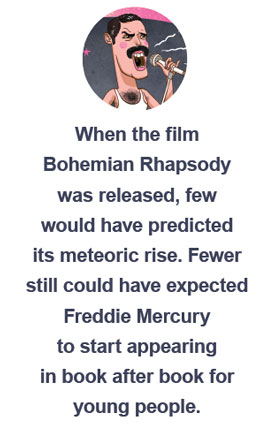Some Trends to Love: In her annual review of children’s literature, Betsy Bird calls ’em as she sees ’em
Among the trends in kids' books, Betsy Bird finds "stories that hope against hope that our children will, with the help of these texts, grow up to be better people than ourselves."
 |
Illustration By Andy Ward |
The act of trendwatching feels akin to divination. Maybe if I just put a little pressure on the Ouija board’s controller, it’ll lead me where I want it to go. So I stepped back and looked at the books before me. What did I see? Well, I saw a publishing market that is increasingly receptive to historically marginalized voices but still has a ways to go. I saw an overwhelming number of titles confronting grief and friendship.
I saw current events and topics in the news filtering into kids’ literature in new and interesting ways. And I noticed a discernible spike in the number of translated titles coming out in a given year, leading me to believe that our palate for books that extend beyond our experience may have expanded.
In short, I saw stories that hope against hope that our children will, with the help of these texts, grow up to be better people than ourselves.
Come over here and sit next to me
When I was a child, it was understood that if a middle grade novel in my school library had a medal on it, the odds were good that it would be depressing. And since I avoided serious subjects like the plague, so, too, would I avoid anything sporting that shiny gold sticker. That perception of award winners persists to this day, and even though the last few medalists have dealt with serious topics, I don’t think you could call any of them misery soaked (some of the Honor books, on the other hand . . .).
The same, alas, cannot be said of a wide swath of very well written, gutting middle grade reads in 2019. The routine among my fellow children’s librarians: “Is anyone in the book you’re reading coping with overwhelming grief? No? Check the pub date, then. You’re probably reading something from 2018.”
This hit its peak in 2019 with several very good books in which a strong daughter must care for her grief-stricken father. The dad in The Line Tender by Kate Allen is probably one of the more capable dads in this category, although he does occasionally strip down to his altogether in the front yard when putting on a wet suit (sample dialogue: “Hello, Lucy… Your father has a hairy keister.” “Yes, he does.” “I don’t like looking at it.” “No, sir.”).
Dan Gemeinhart’s The Remarkable Journey of Coyote Sunrise is an excellent example of a book in which the father isn’t really the parent. With a father firmly wedged within his denial, it’s up to his daughter to make him face the grief he doesn’t want to see. Mind you, the dad with the toughest row to hoe has got to be the one in Hurricane Season by Nicole Melleby. Not only is he dealing with a wife who left him, but with undiagnosed bipolar disorder as well. These three novels are really just the tip of the iceberg, however. In 2019, fiction for kids had them contending with homelessness, the foster care system, parental abuse, parents dealing with substance abuse, and more. Sure, there was lighter fare to be found in the fantasy and science fiction novels. But if you were looking for realism mixed with silliness, that could take a little more digging.
On the picture book side of the equation, empathy is the name of the day. 2019 saw not one, not two, but three books all about buddy benches. Two were simply titled The Buddy Bench, one by Patty Brozo and another by B.D. Cottleston, while Tina Gallo’s easy reader, Come Sit with Me: Making Friends on the Buddy Bench, covers the same territory as well.
These titles sit neatly alongside ones about (you guessed it) grief (The End of Something Wonderful by Stephanie V. W. Lucianovic,Maybe Tomorrow? by Charlotte Agell), deportation (Mango Moon by Diane de Anda), and environmental collapse ( Sea Bear: A Journey for Survival by Lindsay Moore). Each tackles its serious subject matter in a way that’s appealing to young readers, encouraging them to empathize with the situations and characters from an early age.

And that’s the way it is
As much as we’d sometimes love to believe that our children’s books exist in a bubble, far away from the day-to-day happenings of the world, that’s simply not the case. Current events show up in our books without cease. Some of this is rooted in history. In 1969, humans first set foot on the moon. In 2019, you couldn’t take two steps without tripping over a new take on that historic event.
Whether it’s the updated text and art in Brian Floca’s Moonshot, Suzanne Slade’s clever encapsulation of the Daring Dozen, Chris Gall’s picture book memoir Go for the Moon, or even Don Brown’s graphic nonfiction take on the history of space flight itself, Rocket to the Moon, the best books are the ones with something new to contribute.
You’d expect anniversaries like the moon landing to yield STEM-related titles. Unexpected is the influence of cinema. Particularly, cinema with an eye on history. When the film Bohemian Rhapsody was released, few would have predicted its meteoric rise. Fewer still could have anticipated that Freddie Mercury would start appearing in book after book for young people.
You’ll find the Queen frontman on the covers of such titles as Queer Heroes by Arabelle Sicardi and Groundbreaking Guys by Stephanie True Peters. You’ll spy Mercury inside a board book, The Story of Rock, illustrated by Lindsey Sagar. You’ll even find him in slightly more unlikely places, like the nonfiction picture book What Is a Refugee? by Elise Gravel.
Speaking of which, current affairs and events in the news appeared frequently in books for young readers in 2019. Often, authors chose to address their subjects within the context of a metaphor. Consider the appearance of walls in picture books. Titles such as The Wall: A Timeless Tale by Giancarlo Macri and Carolina Zanotti with art by Mauro Sacco and Elisa Vallarino and Humpty Dumpty Lived Near a Wall by Derek Hughes and illustrated by Nathan Christopher, present walls as metaphorical bullies that need to be defeated. These books are fables, a form of storytelling that’s out of fashion in today’s era of stark realism.
Consider the same topic, but rendered in a realistic style. Books such as A Sky Without Lines by Krystia Basil, illustrated by Laura Borràs, and Between Us and Abuela: A Family Story from the Border by Mitali Perkins, illustrated by Sara Palacios, are unafraid to face the harsh truths embedded within the very real walls that exist on our borders today. The uptick in books for readers young and old about refugees further indicates a rise in realism.
In the last five years, the number of refugee titles in the marketplace has skyrocketed, and this year you’ll find the widest range imaginable, starting with the aforementioned basic breakdown by Gravel. Some are straightforward narratives about loss and family. Others, like Lubna and the Pebble by Wendy Meddour and Daniel Egnéus, address the refugee crisis by turning the story into something small, personal, and understandable to a young child. But whatever the case, these books seek to use their story lines as icebreakers, allowing parents the opportunity to discuss these issues with their children.
Translations we’d be remiss to miss
Here is a question that may have no real answer: Are we seeing more translated titles coming to American shores? It can certainly feel that way. Perhaps that’s, in part, because of the wide range of small publishers bringing new titles to the market. They include Cassava Republic (UK/Nigeria), Floris Books (Scotland), Gecko Press (New Zealand), Inhabit Media (Canada/Nunavut), Karadi Tales (India), Pajama Press (Canada), and Tiny Owl (UK/Iran), to say nothing of longstanding publishers in the field such as Enchanted Lion and Eerdmans. Even the big houses are taking more risks and producing more books set overseas, this year featuring creators from Brazil, Bangladesh, Indonesia, Nigeria, and Nunavut, among other countries.
Why the bounty of translated works? Multiple reasons. Perhaps there are economic incentives. Maybe the market is so strong that smaller publishers can get a toehold like never before. But there is one theory that I personally find very appealing. While there’s no way to draw a direct correlation, is it possible that, thanks in large part to the We Need Diverse Books movement, readers have grown more comfortable with the idea of exploring books outside of our immediate spheres of experience? That isn’t the kind of thing you can really measure. It may, instead, be an unforeseen outcome of large populations of readers reading widely and well.
Save us, children
It is impossible to read everything published for children in a single year here in the United States. The market is vast, and the books plentiful. All you can do is step back and sense where the rise and fall of the trends lie. We live in an unstable world where we can find ourselves torn between wanting to reassure our kids that everything is fine, while also feeling an obligation to tell them the truth about what is wrong.
The other day, I heard author Celia Pérez say that often adults just want to sit back and wait for the kids of today to grow up and save the world. Obviously, we should be capable of solving our own problems and not foist them on future generations. But if it comes to that (and my generation is, I must say, awfully good at foisting), at the very least we will be handing them books that will help to give them the kindness, the context, and the worldview they need to better understand how best to save us all.
Elizabeth Bird is the collection development manager of Evanston (IL) Public Library. She blogs at “A Fuse #8 Production” (slj.com/Fuse8).
RELATED
The job outlook in 2030: Librarians will be in demand
The job outlook in 2030: Librarians will be in demand
ALREADY A SUBSCRIBER? LOG IN
We are currently offering this content for free. Sign up now to activate your personal profile, where you can save articles for future viewing






Add Comment :-
Be the first reader to comment.
Comment Policy:
Comment should not be empty !!!